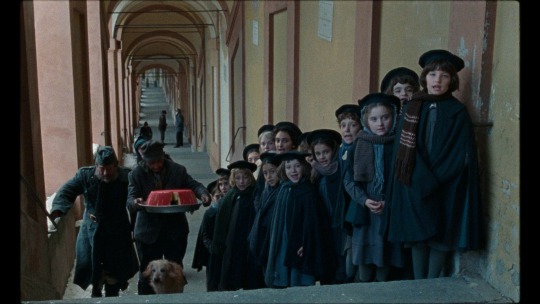#lepupille
Text








Le Pupille (Alice Rohrwacher, 2022)
#dog#dogs#film#films#movie#movies#cinema#perro#perros#pelicula#peliculas#película#películas#cine#dogsinfilm#dogsinfilms#lepupille#alicerohrwacher
2 notes
·
View notes
Photo

Nella categoria Miglior cortometraggio di quest’anno (#BestLiveActionShortFilm) troviamo 5 storie che esplorano con uno sguardo coraggioso i conflitti del nostro tempo: dal tema dell'innocenza a quello dell'accettazione attraverso la scoperta di un legame fraterno, dalla critica ai matrimoni combinati alla denuncia delle molestie transfobiche, fino al tema della ricerca attraverso un suggestivo racconto di formazione. 1.#LePupille 2.#AnIrishGoodbye 3.#TheRedSuitcase 4.#Ivalu 5.#NightRide (LINK nella storia) #AwardsSeason #AwardsRace #OscarsRace #RoadtotheOscar #Movies #AwardsRace #BestShortFilm #BestLiveActionShortFilm #ShortFilm #Oscars2023 #OscarsPredictions #StagionedeiPremi #Migliorcorto #Oscar2023 #FinalPredictions #PrevisioniOscar https://www.instagram.com/p/Co9T1WZMt5-/?igshid=NGJjMDIxMWI=
#bestliveactionshortfilm#lepupille#anirishgoodbye#theredsuitcase#ivalu#nightride#awardsseason#awardsrace#oscarsrace#roadtotheoscar#movies#bestshortfilm#shortfilm#oscars2023#oscarspredictions#stagionedeipremi#migliorcorto#oscar2023#finalpredictions#previsionioscar
0 notes
Text
To Syrah with Love: A Tuscan Wine Star's New Project (Wine Spectator)
There aretwo kinds of debut wines: wines that are simply new, and wines that have animpact.
Elisabetta Geppetti, a pioneer of Tuscany's coastalMaremma region, believesher new wine has the potential for greatness. After more than 30 vintages ather FattoriaLe Pupille, she is releasing her first all-Syrah red, a wine simply calledLe Pupille.
The debut2015 vintage of 250 cases was a group effort with her eldest daughter, ClaraGentili, and winemaker LucaD'Attoma.
LePupille, I discovered at the wine's launch in Milan, is a long, juicy andintriguing Syrah with Mediterranean spice. There's also something different about its style—likely due tofermentation of much of the blend in large, clay, pot-bellied amphorae known inTuscany as orci.
Geppettiis surely a trailblazer. As a young woman in the 1980s, she was among the firstwho saw the potential of the Maremma. Her flagship top wine, Saffredi(2015, 94 points, $125), is a classic super Tuscan blend of Bordeaux varieties thatusually scores 90 points or higher in Wine Spectator blindtastings.
Courtesy of Fattoria Le Pupille
Elisabetta Geppetti has already helped pioneer a developing region in Tuscany and made her winery's name with its Cabernet-Merlot blend Saffredi.
So whySyrah? And why now?
Thegrape, considered an excellent interpreter of terroir, haslong been in the mix at Fattoria Le Pupille.
"I was inlove with Côte-Rôtie from Guigal," explains Geppetti, who inherited Le Pupille in1985 when the father of her first husband, who didn't want to get involved in thewine business, died and left the estate to her. She was 20 years old and hadtaken a keen interest in wine, working with her father-in-law and his friend GiacomoTachis, one of Italy's leading enologists. "Syrah has been a grapeand wine that has been interesting from the beginning."
Geppetti,53, is a bold, room-filling presence—tall, with blue eyes and a mane of tawny-coloredhair. She exudes the confidence of a woman who has lived a full life: twoex-husbands, five children and four star winemakers. (In addition to Tachis,she worked with RiccardoCotarella and Château Latour alumnus Christian Le Sommer beforehiring D'Attoma in 2013.)
All thewhile, she has built Le Pupille from a small family sideline with less than 10acres to an estate of more 180 vineyard acres, now producing a total of ninewines, adding up to more than 40,000 cases a year.
Ever sinceshe began planting Syrah in choice parcels in 2000, Geppetti dreamed of makinga single-variety Syrah red. But she didn't rush it: "To make a pure Syrah, youneed mature vineyards."
Untilnow, Syrah has gone into Le Pupille's RosaMati rosé, which is entirely Syrah;the Pelofino red blend, and, for a time, Saffredi, replacing the small amountof Alicante added to the Cabernet Sauvignon–Merlot blend (later to be replaced byPetit Verdot). Finally, in 2012, mother and daughter began experimenting withmicro-vinifications of Syrah.
Courtesy of Fattoria Le Pupille
La Vigna del Palo is one of two sources for the new Syrah; its grapes for the blend are fermented in open oak casks.
Today, LePupille is blended from a pair of vineyards totaling five acres. It was Gentili'sand D'Attoma's idea to vinify grapes from the cooler and smaller Pian de Fioravineyard in orci—long used for storing olive oil.
Orcihave had a renaissance in Tuscany thanks to GiovanniManetti of Fontodi, who in recent years has experimented with thevessels; his family's terracotta company now produces them for winemaking usingTuscan clay.
Gentili becameintrigued with making wine in clay—a method that allows for microxygenationwithout the tannins added by fermenting or aging in wood barrels.
"The clayhas an influence, but not directly. It really highlights the variety," saysGentili, 27. "We weren't looking to make an alternative wine but a goodwine."
Courtesy of Fattoria Le Pupille
Mother, daughter and the traditional clay orcio in which they are fermenting the new Syrah
For the2015 Le Pupille, grapes from Pian di Fiora were destemmed by hand and, relyingon wild yeasts, fermented in orci,where the juice remained in contact with the skins a full eight months. Therest, from east-facing La Vigna del Palo, followed the same low-tech process butwas fermented in open 500-liter oak barrels for 25 days. The final blend wasaged 10 months in French oak barriquesbefore going to bottle.
Clay-fermentingSyrah over four vintages has been an unpredictable adventure. "Making wine withamphorae is new for us. And at first, I was scared," Geppetti says, "Frankly,every year is very different."
Becauseof the greater oxygen contact in uncoated clay, wine macerations have to be monitored carefully and adjusted to concentrateflavors and aromas and avoid oxidation. While the orci part of the 2015 blendmacerated eight months, for the 2018 harvest that lasted less than fivemonths.
LePupille (the pupils) takes its name from a pair of old farmhouses that localsin the medieval village of Pereta likened to a couple of school kids. It's anapt choice for the new wine, says Geppetti.
"We arelearning," she says. "We are just at the beginning."
source https://www.winespectator.com/blogs/show/id/Tuscan-Star-Fattoria-Le-Pupille-New-Syrah-Project
0 notes
Text
To Syrah with Love: A Tuscan Wine Star's New Project (Wine Spectator)
There aretwo kinds of debut wines: wines that are simply new, and wines that have animpact.
Elisabetta Geppetti, a pioneer of Tuscany's coastalMaremma region, believesher new wine has the potential for greatness. After more than 30 vintages ather FattoriaLe Pupille, she is releasing her first all-Syrah red, a wine simply calledLe Pupille.
The debut2015 vintage of 250 cases was a group effort with her eldest daughter, ClaraGentili, and winemaker LucaD'Attoma.
LePupille, I discovered at the wine's launch in Milan, is a long, juicy andintriguing Syrah with Mediterranean spice. There's also something different about its style—likely due tofermentation of much of the blend in large, clay, pot-bellied amphorae known inTuscany as orci.
Geppettiis surely a trailblazer. As a young woman in the 1980s, she was among the firstwho saw the potential of the Maremma. Her flagship top wine, Saffredi(2015, 94 points, $125), is a classic super Tuscan blend of Bordeaux varieties thatusually scores 90 points or higher in Wine Spectator blindtastings.
Robert Camuto
Elisabetta Geppetti has already helped pioneer a developing region in Tuscany and made her winery's name with its Cabernet-Merlot blend Saffredi.
So whySyrah? And why now?
Thegrape, considered an excellent interpreter of terroir, haslong been in the mix at Fattoria Le Pupille.
"I was inlove with Côte-Rôtie from Guigal," explains Geppetti, who inherited Le Pupille in1985 when the father of her first husband, who didn't want to get involved in thewine business, died and left the estate to her. She was 20 years old and hadtaken a keen interest in wine, working with her father-in-law and his friend GiacomoTachis, one of Italy's leading enologists. "Syrah has been a grapeand wine that has been interesting from the beginning."
Geppetti,53, is a bold, room-filling presence—tall, with blue eyes and a mane of tawny-coloredhair. She exudes the confidence of a woman who has lived a full life: twoex-husbands, five children and four star winemakers. (In addition to Tachis,she worked with RiccardoCotarella and Château Latour alumnus Christian Le Sommer beforehiring D'Attoma in 2013.)
All thewhile, she has built Le Pupille from a small family sideline with less than 10acres to an estate of more 180 vineyard acres, now producing a total of ninewines, adding up to more than 40,000 cases a year.
Ever sinceshe began planting Syrah in choice parcels in 2000, Geppetti dreamed of makinga single-variety Syrah red. But she didn't rush it: "To make a pure Syrah, youneed mature vineyards."
Untilnow, Syrah has gone into Le Pupille's RosaMati rosé, which is entirely Syrah;the Pelofino red blend, and, for a time, Saffredi, replacing the small amountof Alicante added to the Cabernet Sauvignon–Merlot blend (later to be replaced byPetit Verdot). Finally, in 2012, mother and daughter began experimenting withmicro-vinifications of Syrah.
Robert Camuto
La Vigna del Palo is one of two sources for the new Syrah; its grapes for the blend are fermented in open oak casks.
Today, LePupille is blended from a pair of vineyards totaling five acres. It was Gentili'sand D'Attoma's idea to vinify grapes from the cooler and smaller Pian de Fioravineyard in orci—long used for storing olive oil.
Orcihave had a renaissance in Tuscany thanks to GiovanniManetti of Fontodi, who in recent years has experimented with thevessels; his family's terracotta company now produces them for winemaking usingTuscan clay.
Gentili becameintrigued with making wine in clay—a method that allows for microxygenationwithout the tannins added by fermenting or aging in wood barrels.
"The clayhas an influence, but not directly. It really highlights the variety," saysGentili, 27. "We weren't looking to make an alternative wine but a goodwine."
Robert Camuto
Mother, daughter and the traditional clay orcio in which they are fermenting the new Syrah
For the2015 Le Pupille, grapes from Pian di Fiora were destemmed by hand and, relyingon wild yeasts, fermented in orci,where the juice remained in contact with the skins a full eight months. Therest, from east-facing La Vigna del Palo, followed the same low-tech process butwas fermented in open 500-liter oak barrels for 25 days. The final blend wasaged 10 months in French oak barriquesbefore going to bottle.
Clay-fermentingSyrah over four vintages has been an unpredictable adventure. "Making wine withamphorae is new for us. And at first, I was scared," Geppetti says, "Frankly,every year is very different."
Becauseof the greater oxygen contact in uncoated clay, wine macerations have to be monitored carefully and adjusted to concentrateflavors and aromas and avoid oxidation. While the orci part of the 2015 blendmacerated eight months, for the 2018 harvest that lasted less than fivemonths.
LePupille (the pupils) takes its name from a pair of old farmhouses that localsin the medieval village of Pereta likened to a couple of school kids. It's anapt choice for the new wine, says Geppetti.
"We arelearning," she says. "We are just at the beginning."
source https://www.winespectator.com/blogs/show/id/Tuscan-Star-Fattoria-Le-Pupille-New-Syrah-Project
0 notes